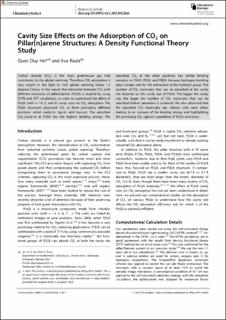| dc.contributor.author | Ho, Quoc Duy | |
| dc.contributor.author | Rauls, Eva | |
| dc.date.accessioned | 2023-10-24T12:59:17Z | |
| dc.date.available | 2023-10-24T12:59:17Z | |
| dc.date.created | 2023-08-14T11:13:36Z | |
| dc.date.issued | 2023-08 | |
| dc.identifier.citation | Ho, Q.D., Rauls, E. (2023) Cavity Size Effects on the Adsorption of CO2 on Pillar[n]arene Structures: A Density Functional Theory Study. ChemistrySelect, 8(29), e202302266 | en_US |
| dc.identifier.issn | 2365-6549 | |
| dc.identifier.uri | https://hdl.handle.net/11250/3098448 | |
| dc.description.abstract | Carbon dioxide (CO2) is the main greenhouse gas that contributes to the global warming. Therefore, CO2 adsorption is very urgent in the fight to limit global warming below 1.5 degrees Celsius. In this report, the interaction between CO2 with different structures of pillar[n]arene (P[n]A) is studied by using DFTB and DFT calculations, in order to understand the effect of P[n]A (with n=4, 5, and 6) cavity sizes on CO2 adsorption. The P[n]A structures physisorb CO2 at three principally different positions called cavity-in, top-in, and top-out. The adsorbed CO2-cavity-in at P[4]A has the highest binding energy. The adsorbed CO2 at the other positions has similar binding energies on P[4]A, P[5]A, and P[6]A, because hydrogen bonding plays a major role for the interaction at the hydroxyl group. The number of CO2 molecules that can be adsorbed at the cavity site depends on the cavity size of P[n]A. The bigger the cavity site, the larger the number of CO2 molecules that can be adsorbed before saturation is achieved. We also observed that the adsorbed CO2 molecules can interact with each other, leading to an increase of the binding energy and highlighting the promising CO2 capture capabilities of P[n]A structures. | en_US |
| dc.language.iso | eng | en_US |
| dc.publisher | John Wiley & Sons Ltd. | en_US |
| dc.rights | Navngivelse 4.0 Internasjonal | * |
| dc.rights.uri | http://creativecommons.org/licenses/by/4.0/deed.no | * |
| dc.subject | kjemi | en_US |
| dc.title | Cavity Size Effects on the Adsorption of CO2 on Pillar[n]arene Structures: A Density Functional Theory Study | en_US |
| dc.type | Peer reviewed | en_US |
| dc.type | Journal article | en_US |
| dc.description.version | publishedVersion | en_US |
| dc.rights.holder | © 2023 The Authors | en_US |
| dc.subject.nsi | VDP::Matematikk og Naturvitenskap: 400::Kjemi: 440 | en_US |
| dc.source.volume | 8 | en_US |
| dc.source.journal | ChemistrySelect | en_US |
| dc.source.issue | 29 | en_US |
| dc.identifier.doi | 10.1002/slct.202302266 | |
| dc.identifier.cristin | 2166681 | |
| dc.source.articlenumber | e202302266 | en_US |
| cristin.ispublished | true | |
| cristin.fulltext | original | |
| cristin.qualitycode | 1 | |

